Nassau Coliseum at 50
By Robert Brodsky
Memories of the 'Old Barn'
Updated February 6, 2022
Sent to HixNews by Linda Piccerelli class of 1960
Bobby Nystrom can still hear the eruption from the capacity crowd at the Nassau Coliseum as he scored the game-winning goal in 1980, securing the New York Islanders their first Stanley Cup championship.
 An overtime goal by Bobby Nystrom on May 24, 1980, gives the Islanders their first Stanley Cup of four in a row.
An overtime goal by Bobby Nystrom on May 24, 1980, gives the Islanders their first Stanley Cup of four in a row.
Captain Denis Potvin holds the Stanley Cup over his head as he skates around the ice at Nassau Coliseum.
Credits: Newsday photo by David L. Pokress; Newsday / Paul Bereswill
"I think all 15,000 fans were on the ice after I scored the goal," recalled Nystrom, who signed his first NHL contract in the Coliseum's parking lot. "The Long Island fans really added a whole other dimension to our success. When we were down, or behind by a couple of goals, they were the loudest fans in the league. It was a helluva building."
Officially known as the Nassau Veterans Memorial Coliseum, the Uniondale arena is far removed from its glory years, sitting dark most days, except for the occasional COVID-19-rescheduled concert or home expo show. And its future, after the Islanders moved to their permanent home at Belmont Park last year, is uncertain.
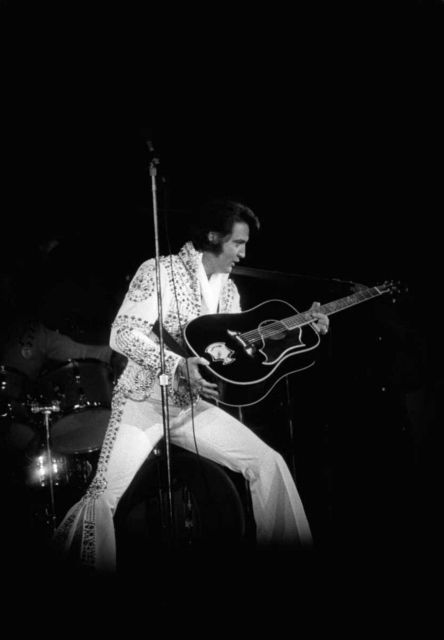
Elvis Presley was on stage performing at the Nassau Coliseum in Uniondale, on June 22, 1973. Credit: Newsday / Jim Peppler.
But as the 'Old Barn' approaches its 50th anniversary on Feb. 11, the venerable arena, which once hosted Elvis Presley, Paul McCartney and four straight Stanley Cup champions, remains arguably the most significant building in Long Island history.
"Nassau Coliseum put Long Island on the sports map, and to a wider set gave national recognition to this area," said Nicholas Hirshon, 36, of Forest Hills, a journalism professor at William Paterson University in New Jersey and the author of a photographic history book on the Coliseum. "Being home to the Stanley Cup champion and so many famous acts brought much more awareness around the world to what Long Island is."
The Coliseum was originally intended as a cog in a grand vision for the Uniondale property, along with a concert hall, museum, library, and gallery. Those plans, as would become a pattern over the next 50 years, never came to fruition.
When the Air Force closed its base at Mitchel Field in 1961, the county acquired most of the land and allocated $32 million in taxpayer funds for a new arena that would allow Long Islanders to avoid trekking into Manhattan to see the world's greatest athletes and entertainers.
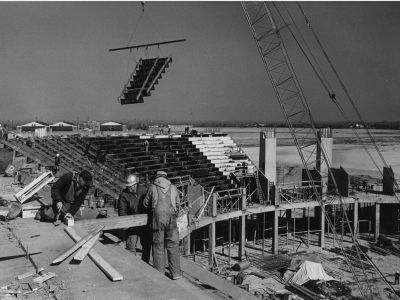
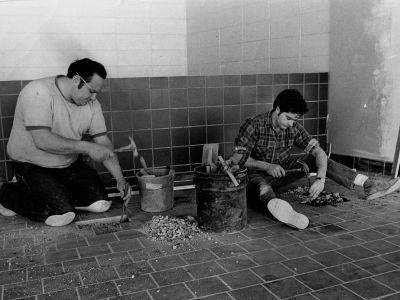
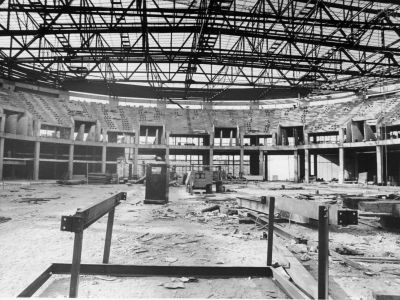
Nassau Coliseum under construction in 1970. Vincent Ferrantelli, of Wyandanch, and John Donnelly, of Oakdale, put the finishing touches on one of the food concession areas during the final preparations for the opening of the Nassau Coliseum in Uniondale, on Feb. 15, 1972. Credits: Newsday / Tom Maguire; Newsday/ Bill Senft
The Coliseum opened Feb. 11, 1972, as nearly 8,000 people (capacity at the time was 15,000) watched the American Basketball Association's New York Nets, who had moved from the Island Garden arena in West Hempstead, defeat the Pittsburgh Condors. The Nets, after merging into the more established NBA, moved to New Jersey in 1977. The Islanders made their Coliseum debut in October 1972, with the expansion team winning just twelve games that season.
The Coliseum was considered state-of-the-art at the time, featuring a digital scoreboard, the first of its kind in an indoor arena, instant replay technology, unobstructed sightlines, and affordable tickets, starting as low as $4.50 in 1972.
During the mid-1970s and 1980s, the Coliseum's resume was virtually unmatched among indoor arenas. Frank Sinatra, the Grateful Dead, Madonna, David Bowie, Bruce Springsteen and of course Billy Joel took the stage. The arena also hosted the 1983 NHL All-Star Game, a Richard Nixon political rally, and WrestleMania II.
Credits: Courtesy of Sony Music Entertainment / Art Maillet; AP Photo/Ron Frehm; John Roca Newsday Photo / Dick Kraus; Newsday/David L. Pokress; Newsday/George Rubei
Sports radio voice Mike Francesa, who was born in Long Beach, recalled watching the Coliseum being built while attending Kellenberg Memorial High School. The retired co-host of the "Mike and the Mad Dog" show interned for two seasons at the Coliseum with the New York Sets, a charter franchise of World Team Tennis.
"I think it is very important that a community have a place where they can see special things: playoff games; college basketball, through the big names of the day," Francesa, who lives in Manhasset, said of the Coliseum.
The arena was never hotter than the early 1980s as the " Fort Neverlose " Islanders won four straight Stanley Cups, making Hempstead Turnpike a perennial parade route.
"The acoustics. The noise and volume. The fans are right on top of the ice. It probably cannot be replicated," said Chris Vaccaro, 35, of Lake Grove, director of the graduate journalism program at Hofstra University who reported on the Coliseum for years. "A tight-knit structure that allowed fans to connect with players unlike any place in North America."
Credits: Newsday / Dick Morseman; Newsday/ Dan Goodrich; Newsday/ David L. Pokress
But the arena had flaws, some minor, others more significant, that were never corrected. The Coliseum had a single narrow concourse, scarce bathrooms, and no access to public transportation. And as the team's fortunes turned, the arena showed its age. Asbestos. Leaky roof. Torn seats. And with the property owned by the county, much of the revenue, and decision-making, was out of the Islanders' hands.
Team owner Charles Wang's plans for the privately funded $3.8 billion Lighthouse Project, with housing, offices, retail, and a luxury hotel, were blocked by the Town of Hempstead. After a public referendum to spend up to $400 million to refurbish the arena was rejected by voters, the team left for Brooklyn.
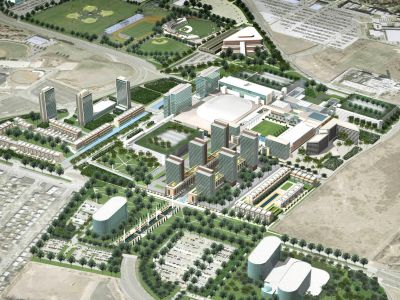
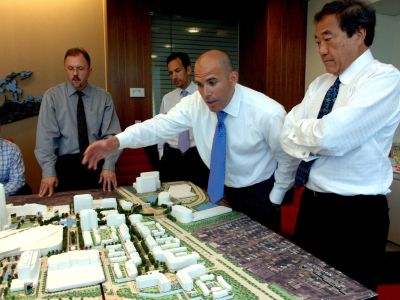
Developer Scott Rechler and Charles Wang, then a co-owner of the New York Islanders, discuss the Lighthouse Project, in 2007.
Credits: The Lighthouse Development Group; Newsday/ Karen Wiles Stabile
The building eventually received a $180 million face-lift, allowing the Islanders a brief return as the Brooklyn marriage fell apart, and while Belmont was under construction. But the combination of COVID-19 and the lack of a true anchor tenant (the Nets' G League developmental team and New York Riptides lacrosse team notwithstanding) has left the Coliseum in limbo.
"The Nassau Veterans Memorial Coliseum had its time and I just hope they leave it there as a landmark and as a reminder of what we did there," Nystrom said.
Master developer Scott Rechler, who did not respond to requests for comment, has said the county could break ground as early as March on a largely privately financed $1.5 billion plan to build housing, offices, biotech research space, "experiential retail" and parking garages around the arena.
In a statement, leaseholder Nick Mastroianni II said the development of the Hub site can create a boost of high-paying jobs while building a location that provides memories for Long Islanders for the next 50 years.
"As we look toward the next 50 years of this institution, we recognize that the world has changed dramatically not just over the past five decades, but over the past two years," Mastroianni said. "The global pandemic has permanently altered the arena experience and with the introduction of the state-of-the-art UBS Arena at Belmont, combined with the decision to make the UBS Arena the new home of the Islanders, a re-imagining of the Nassau Veterans Memorial Coliseum is needed more than ever."
In March, former County Executive Laura Curran waived Mastroianni's rent payments until six months after the lifting of government restrictions on the occupancy of the Coliseum. She later extended that relief through the end of February, according to Chris Boyle, spokesman for current County Executive Bruce Blakeman. Beginning March 1, the leaseholders are obligated to pay an annual rent payment of $4 million, or $333,333 per month, Boyle said.
While the Coliseum's future is uncertain, its place in history is secure. "The legacy of the Nassau Coliseum is a location of some of the greatest moments in Long Island, American and hockey history," Vaccaro said. "That building housed Hall of Famers who played for Long Island on Long Island. There is not a greater sports story to come from this area. There may never be."

